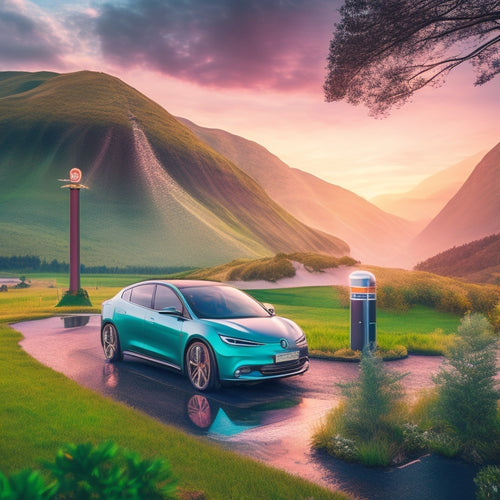
ELECTRIC VEHICLE MARKET: STRATEGIES FOR SUCCESS
Share
As we navigate the rapidly evolving landscape of electric vehicles, it's clear that sustainable growth and market success hinge on a trifecta of strategic planning, infrastructure development, and consumer education. The Indian EV market is expected to surge to 5 million units by 2020, driven by government incentives and shifting consumer preferences towards eco-friendly transportation. To overcome adoption challenges, we need to address high prices, limited charging infrastructure, and customer perceptions of EVs as expensive and unreliable. By developing affordable EV models, expanding charging infrastructure, and educating consumers, we can drive growth and mitigate range anxiety. Further analysis reveals additional key strategies for success.
Key Takeaways
• Developing affordable EV models and expanding charging infrastructure are crucial for sustainable growth in the Indian EV market.
• Investing in innovation and educating consumers about EV benefits can increase customer acceptance and drive market growth.
• Effective business and pricing strategies, considering competition and revenue models, are essential for EV market success.
• Expanding charging infrastructure can alleviate range anxiety and overcome adoption barriers, driving customer adoption of electric vehicles.
• Comprehensive strategies addressing high prices, limited infrastructure, and customer perceptions are necessary for the Indian EV market to reach its projected demand of 5 million units by 2020.
Market Analysis and Insights
As we explore the electric vehicle market in India, our analysis reveals a nascent industry poised for phenomenal growth, with expected demand surging to 5 million units by 2020, driven by government initiatives, rising fuel costs, and increasing environmental concerns.
Market trends indicate a shift towards eco-friendly transportation, with consumers preferring sustainable options. Government incentives, such as the FAME program, and regulations, like the charging infrastructure guidelines, are key drivers of this growth.
We observe that electric two-wheelers and Mahindra Reva dominate the passenger car segment. Our analysis highlights the vital role of government support and battery technology advancements in shaping the market.
Understanding these market trends and consumer preferences is essential for developing effective strategies in the Indian electric vehicle market.
Strategies for Sustainable Growth
To ensure the electric vehicle market in India achieves sustainable growth, we must develop and implement comprehensive strategies that address the industry's inherent challenges, including high prices, limited charging infrastructure, and range anxiety.
We believe that sustainability initiatives are essential to realizing growth opportunities in the Indian EV market. By investing in innovation, we can increase customer acceptance and drive adoption.
This includes developing more affordable EV models, expanding charging infrastructure, and educating consumers about the benefits of EVs. By doing so, we can create a thriving EV ecosystem that supports sustainable growth and reduces our reliance on fossil fuels.
Overcoming Adoption Challenges
We must tackle the entrenched hurdles hindering widespread electric vehicle adoption in India, including high upfront costs, limited charging infrastructure, and lingering range anxiety. These adoption barriers are largely driven by customer perceptions of EVs as expensive and unreliable.
To overcome these challenges, we need to focus on infrastructure expansion, which will have a significant impact on policy and customer confidence. Expanding charging infrastructure will alleviate range anxiety, making EVs a more viable option for consumers. Additionally, policy initiatives can incentivize customers to adopt EVs, thereby driving growth in the market.
Business and Pricing Strategies
By addressing the adoption challenges, we can now focus on developing effective business and pricing strategies that will drive the growth of the electric vehicle market in India.
We need to develop pricing tactics that take into account competition and revenue models that cater to different customer segments. Our pricing strategies should balance profitability with market competitiveness, ensuring we attract a wide range of customers.
We'll analyze the market to identify opportunities for revenue growth, leveraging segmentation to tailor our offerings to specific groups. By understanding our customers' needs and preferences, we can create targeted pricing strategies that drive sales and increase market share.
Frequently Asked Questions
How Can EV Manufacturers Ensure Consistent Quality Across Their Supply Chain?
'We guarantee consistent quality across our supply chain by implementing robust quality control measures, leveraging supply chain visibility, and conducting regular audits to identify and mitigate potential risks and defects.'
What Role Do EV Batteries Play in Reducing Greenhouse Gas Emissions?
We prioritize battery durability and charging efficiency to reduce greenhouse gas emissions, as high-performance batteries with extended lifecycles and optimized charging systems minimize energy waste, supporting a sustainable electric vehicle ecosystem.
Can EVS Be Used as Energy Storage Devices for Renewable Energy Systems?
We explore how electric vehicles can serve as energy storage devices for renewable energy systems, enhancing grid resiliency and peak shaving capabilities, while reducing greenhouse gas emissions and promoting a sustainable future.
How Do EVS Impact Urban Planning and Public Transportation Infrastructure?
We analyze how EVs reshape urban planning, necessitating infrastructure redesign and urban revitalization, as we adapt public transportation systems to accommodate EVs, rethinking cityscapes for a sustainable, emission-free future.
Can EVS Be Recycled and Repurposed at the End of Their Life Cycle?
As we near the finish line of an EV's life cycle, we ponder: can they be revived? Yes, through battery reuse and design innovation, allowing us to breathe new life into retired vehicles, reducing waste and honoring our commitment to sustainability.
Related Posts
-

Why Choose Cool Roofs in Scorching Climates?
You opt for cool roofs in scorching climates because they enable you to reclaim control over your energy consumption ...
-

5 Ways Geothermal Power Boosts Electric Vehicle Efficiency
You're likely unaware that geothermal power can greatly enhance your electric vehicle's (EV's) performance, range, an...
-

What Roofing Materials Best Protect Our Planet?
As you consider the environmental impact of your building, you're likely to find that the roofing material you choose...


